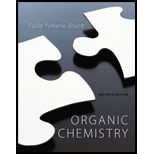
Concept explainers
(a)
Interpretation:
Synthesis of n-pentane from 1-Bromo propane should be shown.
Concept Introduction:
Target molecule is nothing but the desired product.
Terminal
The acetylide carbanion is a good nucleophile and can undergo nucleophilic substitution reactions (usually
3o alkyl halides are more likely to undergo elimination.
One or both of the terminal H atoms in ethylene (acetylene)
The product is also an alkyne; it can also undergo the other reactions.
(b)
Interpretation:
Synthesis of 2-pentanone from 1-Bromo propane should be shown.
Concept Introduction:
Target molecule is nothing but the desired product.
Terminal alkynes are unusual for simple hydrocarbons in that they can be deprotonated (pKa = 26) using an appropriate base to generate a carbanion.
The acetylide carbanion is a good nucleophile and can undergo nucleophilic substitution reactions (usually
3o alkyl halides are more likely to undergo elimination.
One or both of the terminal H atoms in ethylene (acetylene)
The product is also an alkyne; it can also undergo the other reactions.
(c)
Interpretation:
Synthesis of Pentanal from 1-Bromo propane should be shown.
Concept Introduction:
Target molecule is nothing but the desired product.
Terminal alkynes are unusual for simple hydrocarbons in that they can be deprotonated (pKa = 26) using an appropriate base to generate a carbanion.
The acetylide carbanion is a good nucleophile and can undergo nucleophilic substitution reactions (usually
3o alkyl halides are more likely to undergo elimination.
One or both of the terminal H atoms in ethylene (acetylene)
The product is also an alkyne; it can also undergo the other reactions.
(d)
Interpretation:
Synthesis of 1, 2-epoxypentane from 1-Bromo propane should be shown.
Concept Introduction:
Target molecule is nothing but the desired product.
Terminal alkynes are unusual for simple hydrocarbons in that they can be deprotonated (pKa = 26) using an appropriate base to generate a carbanion.
The acetylide carbanion is a good nucleophile and can undergo nucleophilic substitution reactions (usually
3o alkyl halides are more likely to undergo elimination.
One or both of the terminal H atoms in ethylene (acetylene)
The product is also an alkyne; it can also undergo the other reactions.
Want to see the full answer?
Check out a sample textbook solution
Chapter 9 Solutions
Organic Chemistry
- Which reagents are used for reaction 1? a NaN3, ethanol and NaBH4, ethanol, H3O+ b CH3CH2NH2, NaOH c NH3, NaOH d NH3, DCC Which reagent are used for reaction 2? a CH3COOH, DCC b CH3COCH3 and NaBH4, ethanol, H3O+ c CH3COH and NaBH4, ethanol, H3O+ d CH3CONH2 and CH3CH2NH2arrow_forwardwhat is the synthesis of Terephthalic acid? include: figure 1: starting materials + reagents= product 1 figure 2: product 1+ reagents= product 2 figure 3: product 2+ reagents=product 3 figure 4: product 3+ reagents= product 4arrow_forwardChemistry Draw the correct product for the reaction.arrow_forward
- Reagent 1 options: CH3MgBrCH3MgBr MgMg CH3CH2CH2MgBrCH3CH2CH2MgBr HOCH2CH2OH,H+HOCH2CH2OH,H+ Reagent 2 Options: CH3CHO 2. H2O CH3CH2CH2CHO 2. H2O Mg Reagent 3 options: CH3Br CH3CH2CH2MgBr CH3MgBr CH3CH2CH2CHO 2. H2O CH3CHO 2. H2O CH3CH2CH2OH Reagent 4 options: CH3MgBr PCC H3O+ CH3Br Reagent 5 options: CH3Br CH3MgBr CH3CH2CH2MgBr Reagent 6 options: H3O+H3O+ PCC NaOH H3O+arrow_forwardFinished A-C need help with the remaining D-Iarrow_forwardWhen synthesizing acetals and ketals, what is the main driving force behind whether the reaction favors the carbonyl species or the acetal/ketal? a the catalytic acid b solvent c temperature d Le Châtelier's Principlearrow_forward
- what is the synthesis of Terephthalic acid? note: figure 1: starting materials + reagents= product 1 figure 2: product 1+ reagents= product 2 figure 3: product 2+ reagents=product 3 figure 4: product 3+ reagents= product 4arrow_forwardReaction of (CH3)3CH with Cl2 forms two products: (CH3)2CHCH2Cl (63%) and (CH3)3CCl (37%). Why is the major product formed by cleavage of the stronger 1° C–H bond?arrow_forwardDraw the missing starting material. Reagent 1 is benzene and AlCl3. Reagent B is Zn(Hg) and HCl.arrow_forward
- QVI: Starting from benzene as the only organic reagent you have and use any other inorganic reagents to preparearrow_forwardAn activator molecule like DCC is important to create a good leaving group from a -COOH functional group. A. True B. Falsearrow_forwardOrgo Chmistry II HW need help. Please explain why I can't switch the order. Why I cannot make ketone to be the reagent 1 , (Br2, FeBr3) the reagent 2, and( CH2CH3) the reagent 3???? I have answer, but I just do not understand why ketone can't be reagent 1.arrow_forward
 Organic ChemistryChemistryISBN:9781305580350Author:William H. Brown, Brent L. Iverson, Eric Anslyn, Christopher S. FootePublisher:Cengage Learning
Organic ChemistryChemistryISBN:9781305580350Author:William H. Brown, Brent L. Iverson, Eric Anslyn, Christopher S. FootePublisher:Cengage Learning Organic Chemistry: A Guided InquiryChemistryISBN:9780618974122Author:Andrei StraumanisPublisher:Cengage Learning
Organic Chemistry: A Guided InquiryChemistryISBN:9780618974122Author:Andrei StraumanisPublisher:Cengage Learning


